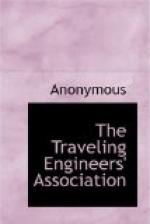A. Any sudden reduction of brake pipe pressure will be felt on the brake pipe side of piston 3, and will cause it and the valve 4 to move to their extreme upper position, the knob on the piston striking the graduating stem 13, causing it to compress the spring 14, moving the emergency valve 15 upward, opening port “Q”; this allows brake pipe air to flow against valve 16, unseating it, then through port “T” to the brake cylinder. (See Fig. 24.) In the meantime auxiliary reservoir air can flow past the end of the slide valve through port “E” to the control cylinder “D” and control reservoir, forcing piston 2 downward unseating valves “I” and “IA”, thus allowing main reservoir air to flow to the brake cylinders, applying the brake.
180. Q. At what pressure will the auxiliary reservoir and control reservoir equalize when using seventy pounds brake pipe pressure?
A. At about fifty pounds; however, with the automatic brake valve in emergency position, there is a small port in the rotary valve (called the blow-down timing port) opened to the control reservoir pipe and control reservoir which allows main reservoir air to flow to the control reservoir and cylinder, raising the pressure to the adjustment of the safety valve.
[Illustration: Fig. 24. Automatic Control Valve. Emergency Position. (With Quick Action Cylinder Cap.)]
181. Q. At what pressure is the safety valve adjusted?
A. At fifty pounds.
182. Q. What types of brake valve are used with this equipment?
A. The automatic brake valve is of the rotary valve type and is the same valve as used with the E-T equipment. The straight air brake valve is of the slide valve type. The control valve takes no part in the application or release of the straight air brake. What has been said of the H-6 brake valve used with the E-T equipment, applies to the automatic brake valve used with the L-T equipment.
BROKEN PIPES
183. Q. If the main reservoir supply pipe to the automatic control valve breaks, what should be done?
A. Plug the pipe toward the main reservoir. The locomotive brake cannot be applied in an automatic service application; but if the control valve be equipped with a quick action cap and an emergency application is made, the air vented from the brake pipe to the brake cylinder will apply the brake. The independent brake will not be affected.
184. Q. What will be the effect if the release pipe breaks?
A. The holding feature of the brake will be lost; that is, the brake will release when the automatic brake valve is returned to release or holding position.
185. Q. If the brake cylinder pipe breaks, can the locomotive brake be applied with the automatic brake valve? With the independent brake valve?
A. This depends on where the pipe breaks; if between the cut-out cock and any one of the brake cylinders, close the cut-out cock to that cylinder, and the other cylinders may be used. But if the pipe breaks between the control valve and the double-throw check valve, the automatic brake is lost; if the break be between the independent brake valve and double-throw check valve, the independent brake is lost.




